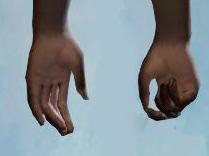
Featured Blog | This community-written post highlights the best of what the game industry has to offer. Read more like it on the Game Developer Blogs or learn how to Submit Your Own Blog Post
Options for Ethnicity in Character Creators, Part 2: Skin and Hair
Are you able to create a wide variety of diverse playable characters in fantasy RPGs? We continue to analyse ethnicity in character creators in fantasy RPGs, part 2 of 3.

This is part two of an article in three parts about self-representation in character creators in fantasy RPGs. The examined games are: Allods Online, Dragon age: Inquisition, Guild Wars 2, Kingdoms of Amalur: Reckoning, Neverwinter, Rift, The Elder Scrolls Online and World of Warcraft.
As we mentioned in the previous part having a character similar to yourself, increases the enjoyment of the game. Now, we’re going to discuss what our study showed regarding hair and skin tone.
Skin
In order to be able to compare the data from the different games, we created a procedure to collect sample of the skin tones. Some games had color palettes showing skin tones and hair color, making it easy to pick the colors. For the games that had no palettes and used a slider instead, the colors were sampled by selecting the midtones. It is ultimately an approximation of the colors, and it could naturally result in small variations in the hues if it were done by different people. However, with enough caution it provided a reliable representation of the available colors if a color palette wasn’t featured in the character creator.

When looking at the available options of skin tones for the human races in every game it can be seen that although they often offer a large number of skin tones, many of them are very similar and a lot of them feel redundant. They don’t provide a wide variety and most of them offer only a few skin tones of a darker shade, but many don’t seem to want to go “too dark”, while having several variations of lighter skin tones. The two or three top rows of colors in Rift looks near identical, and it feels unnecessary to have that many options if there is such a minimal difference, instead of widening the range to a few more lighter and darker shades. The game with the widest variety is Guild Wars 2 that not only has one or two dark skin tones, but several different very dark tones that are varied in both hue and value. It becomes extra apparent when comparing the tones to the other games, most of whom seems to reach a certain value where they stop, Allods Online being the poorest example since they simply chose to exclude all darker skin tones.

But the most noteworthy aspect of the Guild Wars 2 skin tones is that out of all the examined games, it’s the only game that has light palms and soles on the darker skin tones. It shows that they had different ethnicities in mind and actually took care to accurately portray the different skin tones, instead of just doing darker variations of a light skin tone. In many of the other games, it often looks as if they have taken the initial texture of a light skin tone and just changed it to gradually darker shades and made no actual effort in making it look realistic. It feels as if this was the case with for example Allods Online and World of Warcraft. There is no variation in the darker shades and in Allods Online, their darkest skin tone can be another game's lightest. Even though they have such a light shade, they still feel like darkened copies of the lighter skin tones and it can be seen in game. They look desaturated and unnatural and not as thought through as the lighter skin tones.
Some of the interviewees noted that darker human skin tones often look washed out, muddy and not as good-looking as lighter tones, and that there often are only a few token skin tones for different ethnicities, while having a wide selection of light tones. While there may be time or budget constraints that prevent developers from creating every skin tone from scratch, and while most games can not include every possible shade of skin tone, because it’s mentioned by all the interviewees as an issue it’s clear that it’s imperative to put effort in the textures, and to offer variations for all types of skin tones.
It’s also important to note differences in hue variations. One of the interviewees wrote: “Oftentimes there are only token options for non-white characters. There will be only a single Asian skin-tone and eye-shape option, for example.” Just having the the skin tones range from light to dark is not enough, there need to be a variation in the color hues themselves, and this is also applicable to dark tones.
An example of how to solve hue variations in skin tones is present in The Elder Scrolls V: Skyrim, in which they offer additional color for parts of the face, such as cheek, nose, forehead and neck. These are shades of red, brown and gray, and are put on top of the previously chosen skin tone, in addition to complexions, to add further variation. Although it means that there will be more options to go through, it is one possible solution to allow more detailed customization without having to add extra skin tone hue variation on the same skin tone value.
Hair
When we collected data about the hairstyles, the hair textures were divided into four different categories; N/A (Not applicable), straight, wavy/curly and afro textured. Not applicable included all hair styles where the hair texture couldn’t be determined, such as bald and buzzcuts short enough to be of any hair type. Afro textured included cornrows, dreadlocks and the like.

A majority of the interviewees brought up hair as a category they are frustrated with, and for good reason. We could really sense the frustration, and it’s about the fact that there are so few hair styles other than straight textured, and that they are always the same few. “If I want to create a black character, there will often be no curly hairstyles (natural), or other identifiable facial features.” And when we look at the data results, we can immediately conclude that straight textured hair styles take up an overwhelming percentage. The graphs show that little or no effort has been put into including different hair textures, in all the games we studied. The majority of the hairstyles are always straight textured and offer a wide range of different styles that the player can choose from. But in the cases where afro textured hair is included, only a small collection, often with very few differences, is offered.
Dragon Age: Inquisition offers the largest number of afro textured hairstyles compared to their total number of available hairstyles, with 28%. World of Warcraft and Allods Online are last with 0% each, and the game third to last is Rift with 4%. Although 28% may look good in comparison, the hairstyles offered in Dragon Age: Inquisition have little variation and are not allowed the same range of different styles as the straight textured hairstyles. As one interviewee answered: “[Dragon Age: Inquisition] was a complete disappointment in this arena too. There were varying hair types, but everything resembling black hair was basically... six versions of the same short hairstyle.” The Elder Scrolls Online has a smaller percentage, at 17%, but the available hairstyles are different from each other and give the player a wider variety to choose from. There is the standard afro, cornrows and dreadlocks, but also more varied options that we don’t see in other games. It stands out in that regard, since while the majority of the other games we studied try to include more hairstyles than just straight, we got the feeling that these hairstyles were added as token options, to which they could point at if the game is criticized for not including more ethnicities.
.png/?width=500&auto=webp&quality=80&disable=upscale)
There were also not a lot of curly or wavy hairstyles, which were often an even smaller number than afro textured ones. “I understand it is the most difficult thing to render, but I've yet to see a game really blow me away with the hair options offered. Sometimes it is frustrating because the existing options COULD have been very good, but they have something awkward about them…” Hair can indeed be tricky to render realistically, especially in a game where the character can have a lot of different helmets and armor, where different parts of the mesh will cut through itself in unrealistic ways. From a technical point of view straight hair texture might be somewhat faster to make, but every single curl in a curly hairstyle does not need to be modelled individually, just like every single hair strand in straight hairstyles do not. Especially with the simplified style that most of the examined games have, hairstyles can easily be made to give the illusion of the character having curly or wavy hair; some of the games even have good examples of this.
.png/?width=500&auto=webp&quality=80&disable=upscale)
So we’ve established that there are some great examples of varied hairstyles of different textures, so it seems it’s instead a matter of choosing what to spend effort on. And players notice this: “The lack of variety is really infuriating, especially since you can SEE how much effort went into other parts of the game.” It wouldn’t be particularly difficult to take some of the time spent on yet another straight hairstyle and make more varied and differently textured hair options for people of all ethnicities. There needs to be more variety, since the results show so few options for hair textures other than straight and since hair was a category that most of the interviewees were noticeably frustrated with. As one interviewee puts it: “It's like no one has ever seen a black woman unless she has a fro, a short fro, cornrows or is bald”. When only one or two token curly or afro textured hairstyles are offered, it shows that while they are able to include more of them, they chose not to.
In the next and final part we will look at what we observed from examining the data of the facial features and body customisation.
Read the final part here!
Authors: Ylva Ljungqvist, Frida Svensson
This article is a reworked edition, in three parts, of a study we made in June 2015.
Full thesis found here.
Read more about:
Featured BlogsAbout the Author(s)
You May Also Like







.jpeg?width=700&auto=webp&quality=80&disable=upscale)








